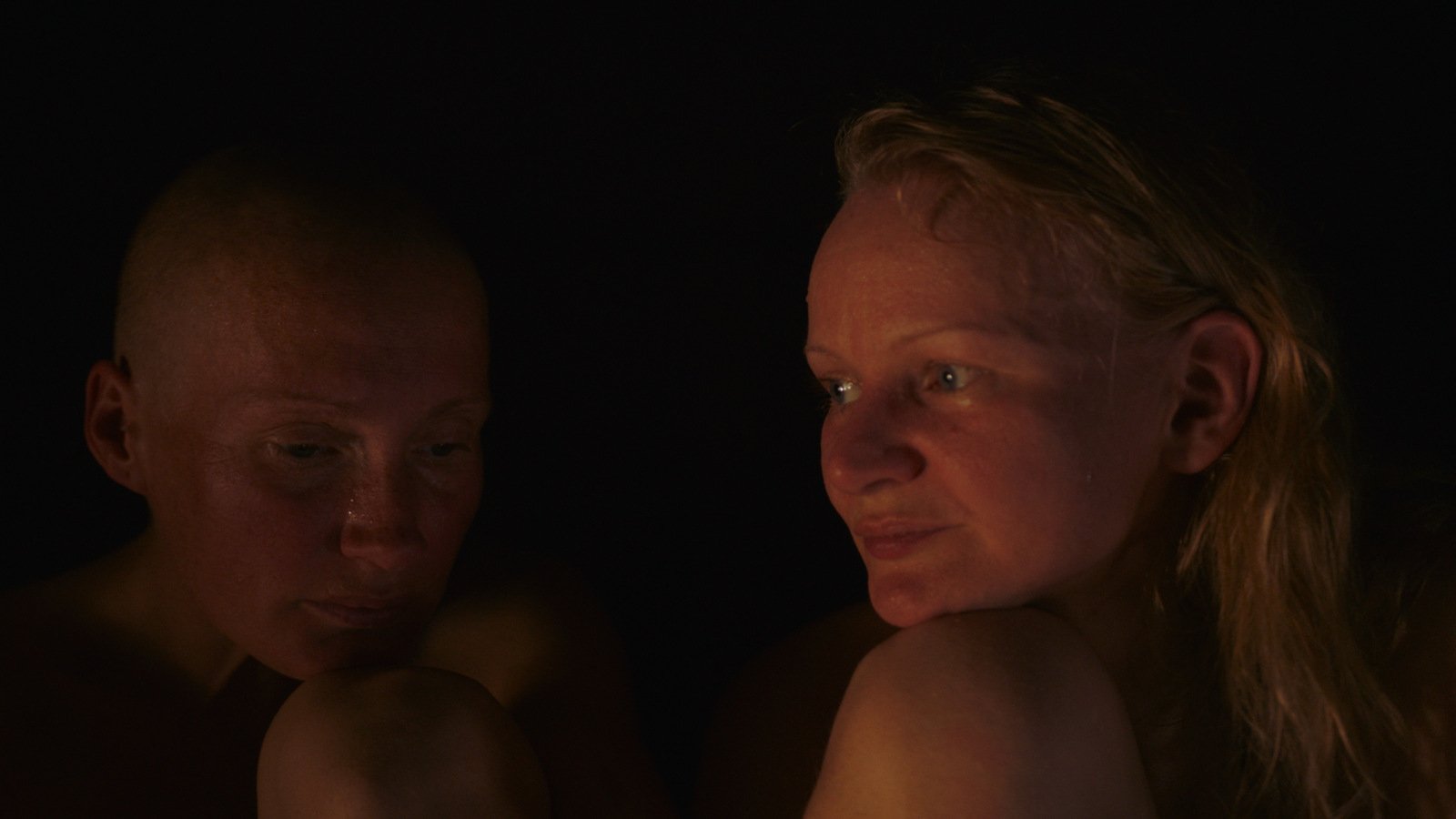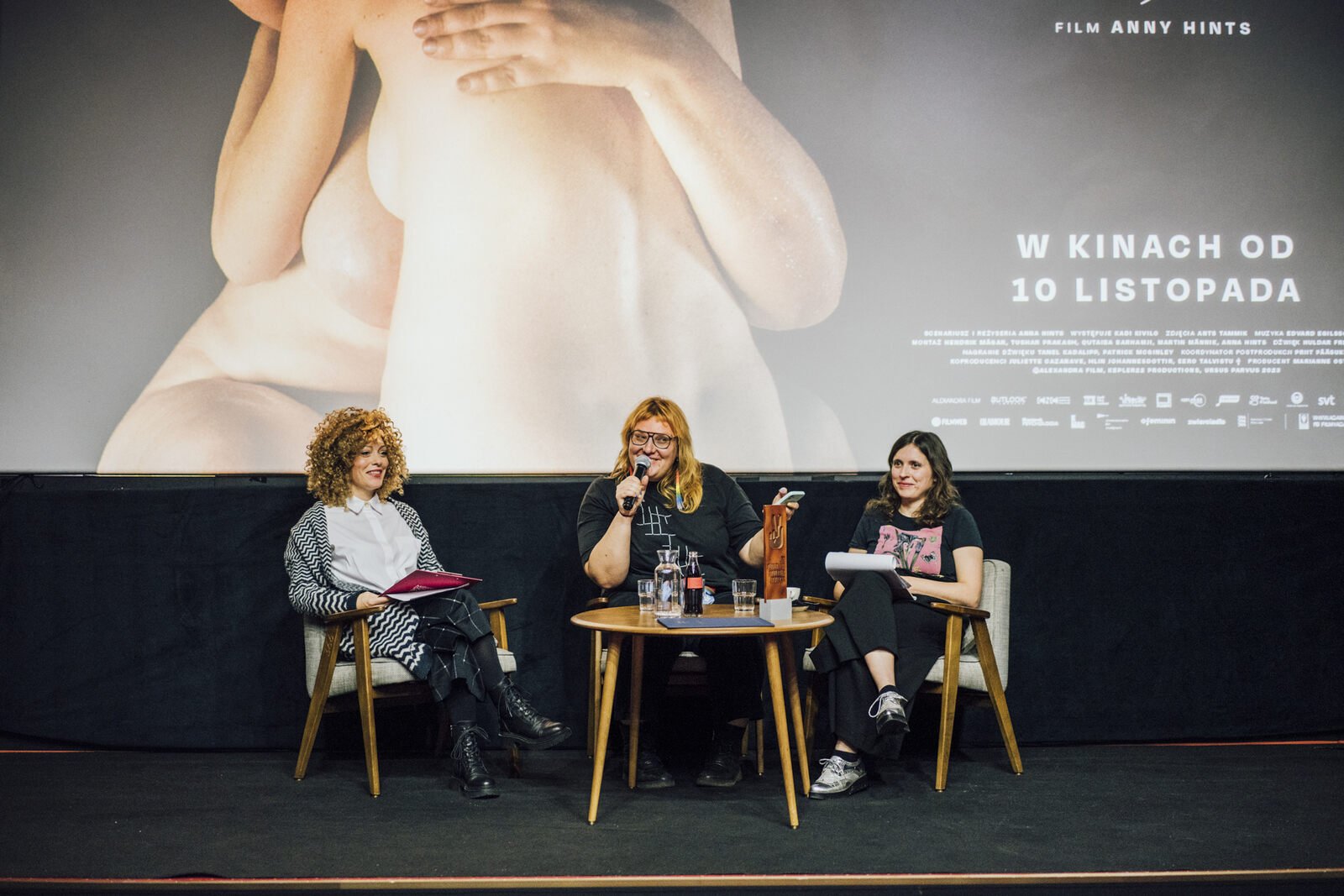Julia Gader
Interview with director of “Smoke Sauna Sisterhood” Anna Hints on audience feedback, shame, and the responsibility of a docu filmmaker.
Inside the South-Estonian smoke sauna, women gather to share intimate stories and wind down from the world that is still putting them under pressure. Anna Hints decided to sit among them for a few years and genuinely give them a voice that would normally stay unheard, within the wooden walls.
Julia Gader: How are you feeling after a whole year of travelling with your movie around the world?
Anna Hints: I promised myself to never complain about the exhaustion from travel I do with my film when in spring I visited California for the first time. I’ve got such a privilege to be able to do what I love and then meet the audiences. Yet I have travelled constantly for a year now and my burning question is how to burn artistically yet not burn out. In the past 2 months I’ve been to 18 different countries, some several times, 3 times to the US… I’m feeling a lot of gratitude because wherever I am there is such a heartwarming response from the audience, long Q&A’s, people hugging me and sharing their stories. Lately at IDFA [International Documentary Film Festival Amsterdam – ed.] screening three women approached me and said after watching the movie they’d started to share intimate things between each other for half an hour. Moments like that give me so much energy.
JG: Do you see any differences among audiences on how this film resonates? After all, it derives from a very local culture story.
AH: I find it interesting that the movie, shot in one unique place, a South Estonian smoke sauna, resonates so universally in the world, from Hong Kong to Australia to the US to Europe. For me it shows the need for a safe space where we can really share and be heard, and also the community experience of being born into a female body. I know many stories of people who saw the film several times, because they treat watching it as personal healing or even more literally like entering a smoke sauna, which helps them get better connected with themselves.



JG: What’s their reaction to the natural nudity shown in the movie?
AH: People enjoy it because it’s not sexualised. Through the lens of another naked female body they’re able to soothe their own body image. A 65-year old woman wrote to me after one screening that she realised that she’d been at war with her body throughout her life and decided to end it by booking a photographer to take nude pictures of herself so that she can further embrace, and reclaim her own body again. I get intimate messages from viewers every day, I hope I can answer all of them at some point.
JG: A cathartic experience?
AH: Yes, but regarding nudity I also got some surprises. I didn’t expect, for example, the UK to still have a certain fear towards scenes with the naked body. There’s a huge sauna movement in the country, but they go there in clothes, so that was eye-opening. In Estonia on the contrary we’re usually fine with nudity, we’re used to it, but there’s still a way to go to open-up emotionally for many people, especially those who are not part of the smoke sauna culture. In Poland or the US, the body context is again different, because here we talk about female rights, including the right to abortion. At the San Francisco International Film Festival there was an applause in the middle of the film where there is this one woman sharing that women should have the right for their body.
JG: Do men go and see this movie?
AH: It moves them as well. Some brave men also wrote to me reflecting on the “male gaze” that they don’t want to look at their wives and daughters with. The film opened their eyes to this, too; they agreed that female bodies are constantly sexualised.
JG: Is the shame experience anyhow common for men and women? Because in your picture, female characters seem to have no shame sharing their intimate stories with each other.
AH: There’s a difference, even in the smoke sauna culture itself. Traditionally it was sex-divided. And while women created a space for safe conversation, men shared to me that they keep avoiding intimacy there and usually sit in silence. I think it comes from the patriarchal mindset that we are all suffering from, and men especially from the pressure to be strong. Vulnerability is seen as weakness and I want to reverse it and say the real strength is to have the courage to be vulnerable.
When we talk about women and shame, in Estonian we’ve even got a word for female genitals that literally translates as “shame”. So as a woman you’re born into a body that is already defined by it. Lot of women in the filming process had shame inside them, but what exactly creates it or what is shameful varies. I don’t like to generalise it too much, though, because it’s dangerous. Even if you have that kind of safe space to share, it doesn’t mean there’s no shame. I find it as an emotion that connects a lot of stories.



JG: The women you chose for the movie seem to be very self-aware, though. They talk openly through their identity and traumas. What did the selection process of the characters look like?
AH: I worked on this movie for seven years, and first of all I think it wouldn’t be possible to make if I wasn’t a voice from within the community. The process itself is integral for the intimacy we see on the screen. I started with a lot of trust, in a smoke sauna sisterhood I’m part of with my friends. I had a rule that I would not persuade anyone. I met with the women and I shared what level of intimacy I was after, and only those who were up for it we continued with. When I sensed that there was any hesitation, for me it was a no. Usually legal papers are signed before filming. It felt wrong to me and Marianne Ostrat [the producer – ed.] to ask women to sign the papers before shooting while asking them to be naked in body and soul. So we took a huge risk and agreed that only in post production, once there is a cut, I will show it to the women and then they have the right to say yes or no. And they only signed the papers once they agreed with the cut.
JG: Did many of them say no?
AH: Actually I had women over the years who were hesitant in the beginning and later changed their mind and wanted to take part. Estonia is a small, 1.3 million person country, so when the news that I’m making such a project spread around, I started to get messages. It developed organically, a new sisterhood. In the film there are 25 different women who are present, but there were more. Surprisingly, no one included had really a problem with what fragments were selected for the final edition. Only one woman wanted to change her voice, because she was afraid her parents would recognize her. I said no, because all the stories you witness on the screen were spoken in front of the camera naturally. I had a rule that we don’t discuss topics before entering the smoke sauna – we get in, experience it and whatever comes, comes. I didn’t foresee that I had to comfort several women, though, whose stories didn’t land in the movie, making sure they know these are important, even if not included in the film. Maybe thanks to their story, somebody else’s story came alive. This is a really difficult part of filmmaking where you have to settle on an hour and a half film from all of the above together. I couldn’t put like 10 rape stories in it, it would be too much.
JG: How long did you edit it?
AH: Actually two years. In my director’s mind I wanted to find a way to form a healing smoke sauna experience in the dark room of the cinema. For this kind of intimate material it had to take time to see how this emotional journey would go. We had over 70 shooting days, and the majority of them took place during the pandemic from March 2020 till January 2021. I normally reside in Tartu, the capital of South Estonia, but then I moved to a farmhouse with a smoke sauna in the South Estonian wilderness for the summer and this became our basecamp. The rest of the crew drove in for four to five day shooting periods. Overall it was a beautiful, deep, and transformative life-affirming journey, and exploration of smoke sauna culture.
A real sauna session like that takes more time, on average around four hours. The film was shot with an ARRI Amira. Temperatures in the sauna went up to 90 degrees Celsius, and during production we lost two lenses and a monitor due to the heat and humidity. We were taking regular breaks to cool equipment down, but not when the sauna rituals and conversations were taking place because we wanted to keep a natural pace of sharing. That was possible thanks to the creativity of our cinematographer, Ants Tammik, whose main focus is visually demanding documentaries.


JG: What other challenges did you face?
AH: We touched on nakedness before, and even though in a smoke sauna you are naked in a non-sexual way – we are there together sweating, peeing and bleeding – at the same, time nude female bodies in society are over sexualized. Before filming I was really scared of how to manage the opposite, the non-sexualised picture, so it took time with the cinematographer to test and find the language of the movie. We tested on my body first, I showed it to the women and they felt safe. Then we followed who wanted to show their face and who didn’t. All of the trust was possible because there were voices included throughout the process, and I realised that it’s not typical at all. It’s a bigger question of how we make our films. You’re never alone as a director. Who are the people around you? Who is the producer? It’s important how you’re supporting each other and sharing the vision together.
JG: You shared some tools you used as a filmmaker to create the intimate atmosphere, but are there any human tools you developed in the creation process?
AH: I think the big lesson I got was to realise that it takes courage to hear the uncomfortable.
In the beginning of filmmaking I thought it was about the courage to share the uncomfortable, and by that I mean the emotions that are usually suppressed, connected with shame or pain. Turns out we can only listen to them when we feel safe. So how do you create this kind of space and is society actually ready to hear each other?
JG: Is it ready?
AH: While listening, we are often occupied with our own thoughts and judgements. When sharing your story it gives you a deep validation from inside, and real hearing this can be healing. For example, when we talk of rape – even after the #metoo movement and opening the discussion, society avoids mentioning rape itself, or people want to take it in a more “convenient” way. But there is nothing comfortable in rape. It’s utterly uncomfortable and it’s about how to be OK with that discomfort, how to be OK as a human with hearing things that are difficult without trying to soften them up. This is where a lot of healing happens. My granny used to say that human traumas are like frozen water inside us. Sometimes we can find ourselves in the deep dark winter, ice within, but we should remember that inside, that ice in me has the power to flow again. We just need warmth to melt our traumas, and I experienced this a lot — personally and inside the smoke sauna, which gives hope that despite our differences, there is the possibility for this kind of human connection. And I cannot give up on that hope. Some may call it naive, but then I think if hope is being called naive, then where are we as humanity?
JG: Do you treat your filmmaking as a mission?
AH: I’m not following that art for art’s sake idea, I don’t even understand it. I feel that art is a consciousness and an artist gives it into the bigger field of awareness. You have to care about certain things and have something to express that comes out of a deep voice inside of you. It’s not that simple, though, because art is in the context of time and space, and I want to emphasise that maybe it’s not about giving answers but asking questions. There is so much complexity in life and art, serving one answer leads to very black and white thinking and that is dangerous.



“Smoke Sauna Sisterhood” was released in Europe in 2023 and is widely available, including for TVOD/EST in the US on Amazon, Apple, Vudu, YouTube, and Google Play.
Film Title: Smoke, Sauna, Sisterhood
Link: https://www.smokesaunasisterhood.com/smoke-sauna-sisterhood
Place (Country/Location): Estonia, France, Iceland
Dates: 2023
Directed by: Anna Hints
Photos by: Ants Tammik, Stanisław Loba

